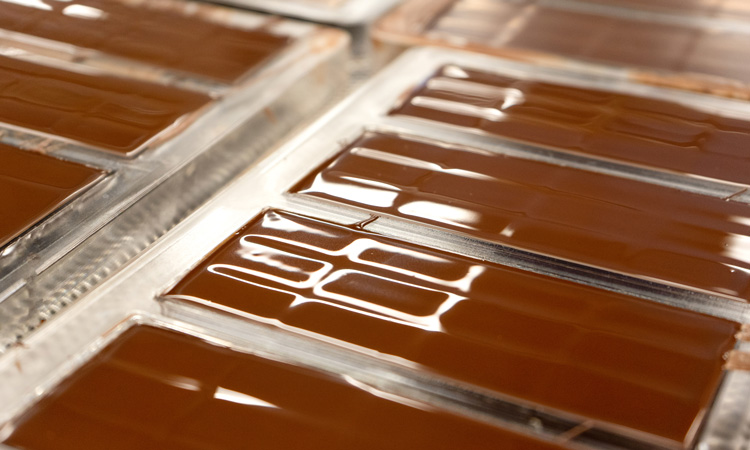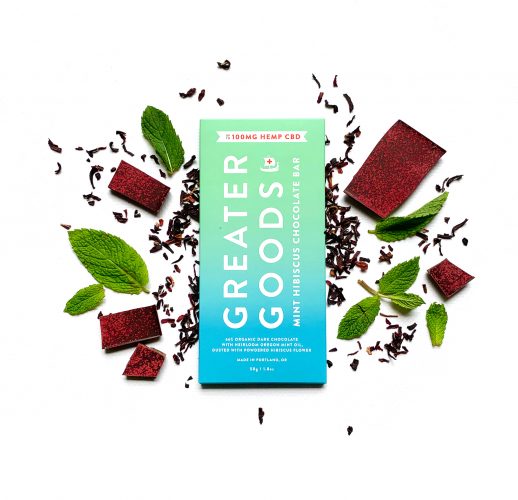When CBD met chocolate
- Like
- Digg
- Del
- Tumblr
- VKontakte
- Buffer
- Love This
- Odnoklassniki
- Meneame
- Blogger
- Amazon
- Yahoo Mail
- Gmail
- AOL
- Newsvine
- HackerNews
- Evernote
- MySpace
- Mail.ru
- Viadeo
- Line
- Comments
- Yummly
- SMS
- Viber
- Telegram
- Subscribe
- Skype
- Facebook Messenger
- Kakao
- LiveJournal
- Yammer
- Edgar
- Fintel
- Mix
- Instapaper
- Copy Link
Posted: 9 January 2020 | Bethan Grylls (New Food) | No comments yet
The health-conscious, environmentally-aware consumer has encouraged new trends in the chocolate sector that affect flavour, texture and harvesting. Greater Goods has gone one step further, infusing the beloved food of the gods with CBD. New Food hears from its Co-founder about why this combination works.


CBD confectionery
The duo started out six years ago as a medical cannabis company with a topical (ie, a transdermal medical marijuana product) and from there they launched an edible line of truffles and chocolate bars. “We saw a huge opportunity in the CBD confectionery space and started Greater Goods in May (of this year),” explained Carrie Solomon, co-founder.
Gummies are one of the most popular forms of eating CBD
Solomon considers edibles as a “lovely way to incorporate CBD into everyday life” and attributes this as the main reason for their rise in popularity. She also believes the body reacts differently to CBD depending on how it is consumed; so edibles offer an alternative experience for users. When it comes to effects, however, claims must be dealt with care. Nothing can be put on the label that boasts health benefits, Solomon told New Food; even suggestions for use are a grey area, as they can be interpreted as directions and, therefore, the product can be classed as a supplement. But, she added, chocolate itself has “amazing health benefits”, with dark chocolate being full of antioxidants, a substance that can prevent or slow damage to cells caused by free radicals.
Gummies are one of the most popular forms of eating CBD, she admitted, but the chemistry of chocolate and the chemistry of cannabis hemp have “really interesting synergies”.
“I also just love chocolate!” she laughed.
She added that gummies are an easy way for companies to enter the CBD space, as they are “easy and affordable to make, and have a long shelf life” and believes that their popularity with consumer(s) may well be down to their abundance on the market. Nevertheless, Greater Goods will be launching their unique version of a gummy early next year.
Experimentation and creation
With regards to product innovation, Solomon said it is mostly about experimentation. “A lot of times we’ll dream up flavour combinations based on what we see lacking in the market. We do a lot of R&D by consuming other creations on the market, but ultimately try to craft something that’s not been done many times before.
“When we start creating, we usually know if it will have mass appeal; but other times, we’ll deliberately try and create something really unique.” She pointed to their mint hibiscus flavour as an example of the unusual combinations they work with. “We use a dark chocolate with mint oil and pulverise hibiscus flower and sprinkle it onto the back. It gives the classic after-dinner mint flavour with a punch of citrus and hibiscus.”
Despite CBD being a key differentiator for Greater Goods, Solomon explained that the sourcing and flavour combinations of the chocolate are essential. “Even if we weren’t offering CBD, we would still want to stand out in the confectionery sector.”
Edibles offer an alternative experience for users
“We produce high-end chocolate, but it is important to acknowledge that the use of CBD in a product does not automatically make it premium. People sometimes charge a lot for a product simply because it has CBD in it, regardless of quality or responsible sourcing; I think that is one of the biggest issues right now.”
The duo produces their chocolate using couverture from a company that provides fair-trade, organic and GMO-free product, as well as certified vegan in the case of dark chocolate versions. However, Solomon said they are also working on a limited edition, single-origin item using a nib-to-bar process. Solomon explained that nibs can come from different origins with each offering a distinct flavour – she and her husband are currently favouring Vietnam.
The nibs are pieces of cocoa bean that are left behind once the shell has been removed via a process known as winnowing. This follows the harvesting, fermentation, drying and roasting stages. Nibs can then be ground, conched (whereby cocoa butter is mixed evenly within the chocolate liquor), tempered and moulded, before being wrapped up for sale.

“Although CBD chocolate production is similar to traditional chocolate making, there are several considerations to be made,” she elucidated. “The way in which the CBD has been extracted and the type of CBD oil make a difference to the taste. Some forms of extraction leave a lot of terpenes. For example, we use a CO^2 and ethanol-produced full spectrum oil that leaves behind a significant amount of linalool, which has a lavender flavour and smell. If you then were to infuse this with a chocolate that has certain flavour profiles, it may not work well.”
The addition of CBD is, of course, another difference to traditional chocolate making. “Once our chocolate reaches temper we put a premeasured amount of CBD into the mixture. Hemp oil is a bit unwieldy – it is very sticky, so you can’t just tip it into the mixture from a jar.” Solomon explained that they create a “chocolate cup” and pour the CBD into this to prevent any loss and ensure it sticks to the chocolate and not anywhere else. “There is a lot of math involved. There’s always chocolate left over in the tempering machine, so you need to account for the medicated chocolate. This is so that when you make another batch, it has the proper potency.”
She added that trust is an important part of their business, not just in terms of being transparent with customers, but also their own confidence with their product. “We provide customers with as much information as possible; including where we have sourced ingredients from and our test results. From a manufacturer’s perspective, ask for a certificate of analysis, find out who the lab is testing with – there should be no hesitancy with their reply. It is also vital to find out where the material is being farmed and request certification – who knows what your product is exposed to otherwise! If you want absolute reassurance, then go and visit the farm and find out that the product you’re using is of high quality.”
References
1. https://www.cargill.com/doc/1432081994701/cargill-cocoa-chocolate-trend-report.pdf
2. https://jamanetwork.com/journals/jamanetworkopen/fullarticle/2753393
About the company
Carrie Solomon and Jody Ake are the creative duo and founding team behind newly launched CBD brand, Greater Goods. This latest venture follows on from their first business Leif Goods, which targeted the cannabis market.


Prior to her work in the cannabis industry, Carrie was an award-winning creative strategist, director and designer in both NYC and Portland, and received a BA in Philosophy from Bard College in 1998, and an MFA in Design from the School of Visual Arts in 2006.









